I’ve just bee(n) reading Gene Kritsky’s “The Quest for the Perfect Hive”, which, though it covers many different sides of apiculture, ultimately focuses on the evolution of hive technology. This, of course, brought me back to thinking about the Voynich Manuscript’s ‘Bee Secrets’ page that I discussed briefly in The Curse of the Voynich.
Back then, I’d wondered whether the page (one of the panels on the reverse side of the nine-rosette page) might have been an enciphered version of Filarete’s book of secrets relating to bees (along with water, machines, agriculture, etc). And so I had discussed the drawings on this page with the tippitty top bee expert Dr Eva Crane (who I’m sad to say died in 2007): she pointed out that the hives apparently depicted there were conical skeps. This is a type of hive thought to have originated in Germany and which beekeepers south of the Alps almost never used (they instead used horizontal log hives).
The Four Skeps
In the top left ‘skep’, the beekeeper might possibly be smoking the bees out of a hole in the top:
In the top right ‘skep’, we see a stylised bird (not sure what this represents) and bees going in or out of the bottom (this is one of those Voynich drawings where we seem to have an original layer and an obscuring layer on top, others like this are in Q13):
The bottom left skep is oddly stylised and apparently multi-stage, and it’s not clear what the beekeeper is doing (perhaps smoking the bees out?). The dots in the body, however, appear to be where the honey / honeycomb would be, so perhaps some kind of honey extraction mechanism is what is intended here:
Finally, the bottom right skep has the mysterious bird again, and again the inner (dotted) honeycomb seems to be exposed:
What Does It All Mean?
Oddly, Dr Crane’s observation hints that this single page might offer us a microcosm of the secret history of the Voynich Manuscript: a German bee-keeping technique, perhaps with a mechanical innovation added by the author, all concealed in plain sight, and being re-presented for an Italian audience. And this doesn’t necessarily have to have anything to do with Filarete (whose personal motto was the industrious bee) for it to be true.
What I learned from Gene Kritsky’s book (pp. 160 ff.) was that accounts of bee-keeping often included “bee calendars”, that told bee-keepers what to do in different months, zodiacal signs, or seasons. And I’m now wondering whether that accounts for the way the writing on this page appears in four directions, i.e. the four seasons of bee-keeping:
In terms of a block paradigm match, therefore, I currently believe the source material for this page will turn out to be an early (1380-1450) account of conical skeps written in Italian (or possibly Latin), derived from Northern European sources (probably German, possibly Swiss), and with four paragraphs corresponding to the four seasons of bee-keeping.
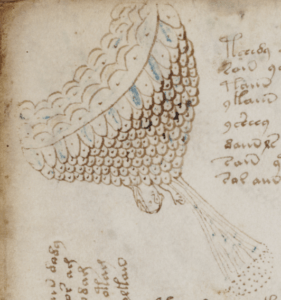
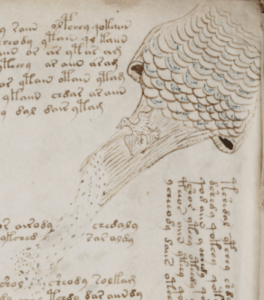
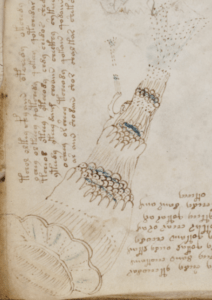
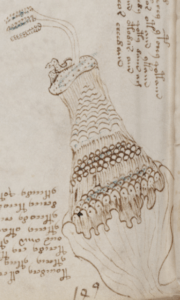
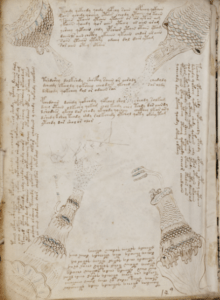
Some texts – courtesy of the ‘Medieval Bestiary’
https://bestiary.ca/beasts/beastsource260.htm
and I see you do not budge on the rosettes page. [smile emoticon]
Diane: some good texts there, but there are plenty more out there. I’m trying to bridge the gap between Pietro de’ Crescenzi (d.1320) and Girolamo Ruscelli (1538-1566) / Ulisse Aldrovandri (1522-1605) for my next post.
There’s a great-looking book on Italian Apiculture which doesn’t seem to be for sale or in libraries anywhere (literally zero copies in WorldCat, which is a bit unusual – I’m wondering whether they actually printed any).
Nick,
In depicting the man-made beehive, some medieval images employ a parallel wave pattern for the surface – echoing the steps of the natural hive, while others seem – at least to me – to mean to evoke the basket-woven pattern of the skep as e.g. British Library Royal 12 C XIX f. 45)
I look forward to seeing illustrations from the Italian works you mention.
D.N.O’Donovan: no doubting that the “stylised bird” in NP’s “four Skeps” be none other than the ellusive ‘greater honey guide’ (certainly looks like one), a native to Mozambique that has a quid pro quo deal with humans to locate hidden wild nests ripe for plunder. This be in turn for unwanted hive waste and help with mating. All fits with the time of Portuguese settlement of it’s first African colony (1506) and suits sans C14 miscreants having post 1432 Voynich Manuscript dating theories.
John – did you know that classical writers regarded the bee as a form of bird, or that in some sources used in medieval times, it wasn’t a queen bee but a king bee thought to rule the hive? Now you do. 🙂
…and then there was the “greater honey guide” and still is, a bird with feathers, beak and all. Sure don’t look like no honey bee to me, but it’s a tough call when you know stuff all.
Regarding this train of thought. The tiny dots in the “honeycomb” would more likely represent eggs. Any beekeeper looking at these illustrations would immediately come to that conclusion.
John,
if you do really do know someone who thinks the bird a species native to Mozambique, it seems they support Nick’s ‘hive’ theory – which is nice for him.
What they need to do then is to show how people drew things like birds and beehives in that region before 1440.
It’s not beyond all possibility, even if so very little remains from that earlier time – after all, the world beyond Europe was not uninhabited, or occupied by less intelligent people waiting for a ship-load of gold-mad, insanely arrogant, uncouth Portuguese to turn up.
It would be interesting to know if da Gama knew Idrisi’s geography, or had heard of Ibn Battuta’s travels – Battuta being another native-born North African, whose account of east Africa dates to the fourteenth century.
https://sacredfootsteps.com/2023/07/03/ibn-battuta-in-east-africa/
yeah, yeah… I get the symbiosis thing.
Nick,
You might want to check your sources for the statement that skeps were invented in Germany.
I’ve been looking around for a timeline of skeps and how they are represented in art. On one site I found the following…
“the first structured beehives emerged later in ancient Greece and Rome in the form of skeps. Skeps were typically made from coiled straw or wicker, resembling a domed basket with an entrance for the bees. These simple yet effective structures allowed beekeepers to manage colonies and extract honey, although their design lacked the ease of modern hive inspection.
In Northern Europe, log hives were prevalent during the medieval period. These hives were hollowed-out logs with a small entrance hole, providing natural insulation and protection for bees in harsh climates. Log hives remained popular for centuries due to their durability and suitability for cold weather conditions.
It’s from an article written mid-2024 and updated in Dec.2024 – for the ‘Planet Bee Foundation’.
https://www.planetbee.org/post/evolution-of-beehives-a-journey-through-time
In terracotta, to be used as a coin-bank, a Roman artefact in that form, dated 2nd-3rdC AD. (not sure why the museum classed it as something for children)
https://archaeologicalmuseum.jhu.edu/class-projects/archaeology-of-daily-life/childhood/beehive-savings-bank/
Plenty of evidence for skeps – not any for drawing them like the Voynich folio so far.
The 10th century Geoponika, a twenty book compilation of agricultural lore, contained a section on apiculture. it was compiled for the Byzantine Emperor Constantine VII.
https://en.wikipedia.org/wiki/Geoponica
Go to the bottom of the page and click on Translation by Thomas Owen – see from p 226 onwards for a discussion of both the practical aspects of beekeeping and the religious and symbolic importance of the bee. The bee is seen as an organised and wise animal that is a shining example to humans, and their society reflects God’s order.
“The bee is the wisest and cleverest of all animals and the closest to man in intelligence; its work is truly divine and of the greatest use to mankind. Its social life resembles that of the best regulated cities. In their excursions bees follow a leader and obey instructions. They bring back sticky secretions from flowers and trees and spread them like ointment on their floors and doorways. Some are employed in making honey and some in other tasks. The bee is extremely clean, settling on nothing that is bad-smelling or impure; it is not greedy; it will not approach flesh or blood or fat but only things of sweet flavour. It does not spoil the work of others, but fiercely defends its own work against those who try to spoil it. Aware of its own weakness, it makes the entrance to its home narrow and winding, so that those entering in large numbers to do harm are easily destroyed by the guardian bees.
This animal is pleased by a good tune: when they are scattered, therefore, beekeepers clash cymbals or clap their hands rhythmically to bring them home. This is the only animal that looks for a leader to take care of the whole community: it always honours its king, follows him enthusiastically wherever he goes, supports him when he is exhausted, carries him and keeps him safe when he cannot fly. It particularly hates laziness; bees unite to kill the ones who do no work and use up others’ production. Its mechanical skill and near-logical understanding is shown by the fact that it makes hexagonal cells to store honey.”
On the hives it states:
“The best hives, that is, containers for the swarms, are made from beechwood boards, or from fig, or equally from pine or Valonia oak; these should be one cubit wide and two cubits long, and rubbed on the outside with a kneaded mixture of ash and cow dung so that they are less likely to rot. They should be ventilated obliquely so that the wind, blowing gently, will dry and cool whatever is cobwebby and mouldy…”
It also discusses the seasonal care of bees:
“As food for young bees put out wine mixed with honey, in basins, and in these place leaves of many-flowered savory so that they do not drown. To feed your swarms in the best possible way whenever they stay at home because of wintry weather or burning heat and run out of food, pound together raisins and savory finely and give them this with barley cakes. When the first ten days of spring are past, drive them out to their pastures with the smoke of dried cow-dung, then clean and sweep out their hives: the bad smell of the dung disturbs them, but cobwebs are an obstacle to them. If there are many combs in the hives, take away the worst, so that they are not made unhealthy by overcrowding.”
People still underestimate the importance of Byzantium and the Macedonian Renaissance to the later Italian Renaissance.
Bees were often thought to have originated in Paradise and were seen as symbolising chastity.
https://historyofbees.weebly.com/bees-and-catholicism.html
https://buzzingaboutbees.com/bees-symbolize/
There are some medieval depictions of birds and bees here:
https://blogs.bl.uk/digitisedmanuscripts/2019/08/the-birds-and-the-bees.html
The worker bee is also the symbol of Manchester (a hive of industry) and indeed the most famous Manchester beer Boddingtons (the brewery is now closed) used the bee on its logo. I saw the legendary “icon” Nico supping a couple of pints of Boddies after her performance at Manchester’s Band on the Wall.
https://uk.pinterest.com/pin/pinterest–404831453981409837/
https://www.manchestersfinest.com/articles/symbol-city-manchester-bee/
Folks who want the real buzz on bee hive secrets and how the Mozambiquees found them in the forest in the days pre Vasco da Gama and still, you’ll find it all laid out and readable in Wikipedia under ‘Greater Honeyguide’, a member of the passerine (woodpecker) family. No need to post further detail in my own words that would only bore you all shitless, eh Nick, Diane, Syph?
Diane: yes, skeps themselves are ancient, but the history of their use is not as straightforward as the page you linked to suggests. I’m revisiting the history now, trying to build up a clearer picture…
I could have swarm that my bee seeking ‘greater honeyguide’ be a cookoo but alas, seems it be related to the woodpecker in its looks, treed habitat and by nature it be quite vocal, territorial and inclination to be a loner unless seeking a a bit of fluff. Such being the case stands to reason why only single birds appear in Nick’s breath of fresh air ‘Bee Secrets’ page. If my input be taken seriously (a first) this could result in a need to rethink acceptance of the 2009 (no official report) carbon dating 1404/38. That’s half a century before the Vasco da Gama sailed from Lisbon on a voyage of discovery to Africa and beyond. Wonder who was it came up with ‘the bird is the word’, maybe it was Wilfrid Voynich, Heaven forbid if he did.
Steve H.,
If you want to get your teeth into an interesting question, try ‘What relationship might there be between the Roman bucolic and agricultural texts, the now-lost work of Mago, and the Geopontica?’ Should keep you busy for a while. Then you can move up to the question of the degree to which the ‘Arab agricultural revolution’ theory is (a) well-based and (b) relevant.
😀
Probably doesn’t need saying that skeps similar to those in VM are typical of those produced by natives of Mozambique from the onset of early hunting and gathering collectives. They were made in the hundreds and distributed haphazardly around forests they inhabited and even further afield depending on which flowering trees were attractive to wild bee populations thereabouts, hence harvesting would have been more arduous. Even moreso and time consuming, that being without a little help from their feathered friend, the greater honeyguide.
In case anyone is interested.
The bee most commonly kept in the Middle Ages was the Apis mellifera mellifera. Also called the alpine bee.
It is European, peace-loving and hardy. At 25 million years old, it is one of the original bees.
https://de.wikipedia.org/wiki/Dunkle_Europ%C3%A4ische_Biene#:~:text=Die%20Dunkle%20Europ%C3%A4ische%20Honigbiene%20(Apis,und%20der%20Urtyp%20aller%20Honigbienen.
Maybe someone will be interested. But the folio says nothing about bees. And it says nothing about beehives either. Of course it says something about a bird. But it is not a bee eater and it is not a predator either. Eliška z Rožmberk writes about sub. (SUP is a bird) Substitution. At the top right, it will show you the substitution of the number 3 again. And the text says: I am throwing away the code. They are small dots. (it looks like ashes are being scattered). The translator cannot translate the Czech word ” s.y.p.u. “. So in Czech it is written ” S.y.p.u. c.o.d.
Peter M.
Only 100 million years out with your not so original peace loving, Euro bee, tree puller.
Nick,
I think the author of that ‘Planet Bee’ page assumed that a ‘bole’ must refer to a tree… hence logs.. but that isn’t necessarily so. A ‘bee-bole’ was a structure, a wall, or a building, which contained a number of alcoves or niches, into each of which a skep could be placed.
I expect you know this already, but some of your readers maybe interested.
I don’t want to be a spoil-sport, but the Voynich drawing’s tower-like structures present a problem, especially when there’s nothing in the drawing unmistakeably bee-shaped, and nothing with the skep’s characteristic bell-shape, so to maintain the ‘bee’ theory here, I’m guessing those towering forms would have to be argued description of some natural habitat or – perhaps – bee-towers, if there was such a tradition in Europe or anywhere else.
Nick’s theory is a theory about the intention behind a certain drawing, so before taking the interpretation as a given, and to avoid its being shot down, I think Nick’s reading of it needs to be provided more art-historical grounding.
I’ll be keeping an eye open for anything that might help.
Then of course you have your ‘scaley throated honeyguide’ nest thief bird that got into the ‘quid pro quo’ act early in the anals of homo/anthophila co-existance by engaging with stone age Hanza hunter gatherers of Northern Tanzania for to locate wild bee hives and share in the spoils, though not always equally. Pity it couldn’t have been C. Friedman’s (not William the crypto) falso honeyguide out of Monza in North Eastern Italy
I agree with Diane.
I also don’t think the site has anything to do with bees or beekeeping in any sense.
I think it’s more about nutrition. The dispute between humans and nature over resources.
This would be a topic that is not visible in the VM, but appears in other books.
@John Sanders
With the 100 million years you are talking about wild bees in general.
However, these are not state-forming honey bees but solitary bees.
But we are talking about honey bees and keeping them
How are things in Glocca Morra?
Yep, I’m a little skep-tical (ho! ho!) about the birds and the bees myself. Specially the bees. The third and fourth “skeps” look more like plants to me, maybe releasing pollen. And the little feller in picture three appears to be naked which might not be advisable when handling our apian friends. A sting in the tail would be the least of it.
Veg has obviously fallen for it. No, a cat hasn’t bitten my tongue soldier. but I’m beginning to be a bit of a star on Reddit after a shaky start, regaling all the trendy young things with tales of my adventures seeing all those cool bands back in Manchester in the ’80s and going to the hippest and now legendary clubs and venues. Green with envy they are, especially the Yanks, and I don’t blame ’em. I’ll have to find somewhere to tell all my yarns about my travels and travails in the Outback cos the young people love Australia, God bless ’em. When they find out about my brushes with man-eating crocs and near misses with crazy truckers and knife wielding psychos, let alone my encounter with supernatural entities in Arnhem Land, they’ll be swooning. And I’ve had 138K views of my forensic analysis of the Henry McCabe voicemail although it’s still only 93% positive on the upvotes. Feel free to visit and give it a thumbs up pal.
And Diane, the only Mago I know anything about is the “magickal” island of Tago Mago off the coast of Ibiza, near where I holidayed with the rellies in 1975. Supposedly associated with Aleister Crowley, the islet also gave its name to my favourite album of all time, Can’s Tago Mago.
I have now thought again about the symbolism of the drawings.
After 2 beers I realised that they might be signs of the origin.
That’s how I see it in religion, origin from heaven, or even Quire 13, as origin, or origin from the previous.
Enlightenment thanks to per mille. o/oo. (promille)
Fucking translator.